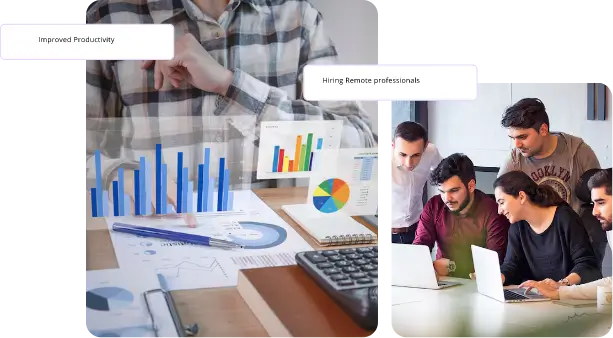Home / M / Multi-Location Attendance
What is Multi-Location Attendance?
A multi-location attendance management system tracks and manages employee attendance across multiple work sites from a centralized platform, ensuring accurate, real-time data collection and streamlined workforce monitoring, regardless of location. It helps organizations maintain consistency, improve efficiency, and simplify attendance tracking across geographically dispersed teams.
Today, instead of using separate systems at each site, companies are choosing advanced multi-location tools that offer centralized tracking through a single dashboard.
This helps organizations with a distributed workforce, a workforce that has a network of locations that includes retail, franchises, remote employees, and/or submissions to clients and servicing orders on-site. The latest multi-location attendance management systems are established on the cloud and collect data in real time, often through biometrics, GPS, geofencing, and mobile apps.
Why is Multi-Location Attendance Important?
With companies growing beyond one office, it becomes increasingly important to have an integrated view of all employees in a single place to drive operational efficiency. There are a few reasons why this concept is so important when it comes to modern-day workforce management:
- Centralised Command: You can track employee attendance across all branches without needing to create separate records for each location.
- Compliance Assurance: It also ensures that attendance policies are applied consistently across your organization and good for keeping you compliant with labor laws.
- Minimizes Error and Fraud: A sophisticated system can track anomalies such as buddy punching.
- Supports Hybrid & Remote Teams: Manages employees across various work environments, including site, off-site, and remote arrangements.
Examples of a Multi-Location Attendance
Here are some examples to illustrate how multi-location attendance works in practice:
- Retail Chains: A retail chain with 50 stores has implemented a centralized attendance system that allows store managers and HR to view attendance logs for all workers in the chain.
- Construction Companies: Resourceful supervisors use time and attendance mobile apps that have GPS tagging capabilities to track the times that field workers clock in and clock out at multiple project sites.
- Remote Teams: A tech company that has offices in multiple cities and also employs remote developers uses cloud-based time tracking to capture the clock-ins from all locations instantly.
How Does Multi-Location Attendance Work in the Workplace?
A multi-location attendance system works by integrating various check-in methods, such as biometric devices, mobile apps, and online portals, into one unified platform. A step-by-step explanation of how it works is as follows:
- Device Integration: Each of our locations may use different hardware, including fingerprint scanners, face recognition, and QR codes. Communication between these devices and a central system is possible.
- Cloud Synchronization: Attendance data from all points of entry is stored on a cloud server and will sync in real-time.
- Geo-validation: For remote workers and field staff, geo-fencing ensures attendance can only be marked when an employee is in a designated work area.
- Manager Access: Supervisors and HR have access to attendance records through dashboards that display data across locations and teams.
- Reporting & Analytics: Organizations generate reports to compare trends in attendance, late arrivals, and absenteeism between locations.
This real-time, integrated approach ensures consistency and transparency regardless of where employees are located.
Key Benefits and Risks of Time Correction Requests
Benefits
- Real-Time Visibility: See who is present wherever in one or more branches or teams.
- Consistent Policy Application: Implement consistent rules for attendance and leave entitlements between border crossings.
- Better Staffing Schedules: Access to accurate attendance data helps create efficient schedules and allocate resources more effectively.
- No Mistake Payroll Processing: Accurate & error-free attendance tracking with built-in integration to all leading payroll systems.
Risks (if not managed)
- Data Synchronization Problems: For example, if the internet is bad at one site, the system can be down, and you won’t receive any entries.
- Privacy considerations: Employees may object to GPS or biometric tracking if it is not handled transparently.
- Mixed use of the Devices: Using various devices at different sites without standard rules may create integration problems.
- Training: Workers and managers in branches might require training to be able to use the new tools effectively.
Multi-Location Attendance vs Location-Based Tracking
These terms may sound similar, but there are some key differences:
| Feature | Multi-Location Attendance | Location-Based Tracking |
|---|
How Time Champ Helps with Multi-Location Attendance
Time Champ has added features to help manage the attendance of employees in multi-site/work-from-home scenarios.
- Cloud-Based Platform: You can aggregate all your office data and see everything in one central dashboard.
- GPS and Geofencing: The best methods for tracking field teams.
- Device Synchronization: Works with all the biometric/digital attendance devices in other offices.
- Cumulative Shifts: Manages multiple regions with flexible and rotating schedules.
- Real Time Reporting Alerts: HR and/or the management department can be notified of late arrivals, missed punches, or patterns away from the norm for all work sites.
Time Champ makes it simple to manage & record attendance across all site offices, offsite desk, or client site.
Related Terms
- Geofencing: An attendance mark can only be made within a geofence, which is a digital perimeter around a physical location.
- Cloud Attendance System: This is an online system that records and stores attendance remotely.
- Remote Work Monitoring: This is a way of tracking which remote workers are productive or what attendance activity is happening outside of the main office.
- Biometric Attendance: This is an attendance authentication system relying on fingerprint scanning, facial scanning or iris scanning.
- Shift Scheduling: Assigning specific work times to your employees across multiple locations or time zones.

